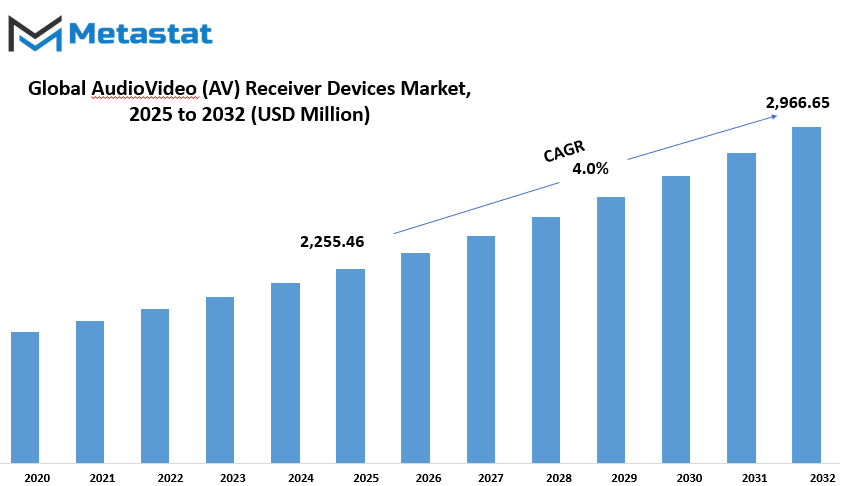MARKET OVERVIEW
The Global AudioVideo (AV) Receiver Devices market will not remain confined to traditional functions such as audio amplification and signal processing. Manufacturers are likely to install advanced machine learning algorithms in these devices, thus enabling them to gradually evolve into personalized devices based on preferences of users, optimize sound output according to environmental acoustics while offering voice-controlled functionalities among other innovative features. The AV receivers of tomorrow will act as central entertain hubs of their respective ecosystems, effortlessly integrating with lighting systems, virtual assistants, and even security networks. Transitioning to this kind of technology is going to add to the convenience of people and bring about a transformation in the definition of home entertainment into a much more individualized and immersive experience.
Due to the increasing demand for connectivity solutions for home entertainment experiences, the Global AV Receiver Devices market has witnessed a growth trajectory. The industry, in turn, is constantly trying to change how people now interface with sound and visual systems through technological changes. These devices will find applications, other than the traditional roles in home theater and professional audio settings, integrating artificial intelligence, automation, and smart ecosystems to redefine the viewing experience.
As for the changes in the commercial sector as demand for high-quality AV receivers increases amongst companies to support hybrid working systems, virtual events, or large-scale digital presentations, With a rise in remote and hybrid working models, organizations will be looking for sophisticated AV solutions for seamless communication. The Global AudioVideo (AV) Receiver Devices market will address this need by developing models with advanced video conferencing features, real-time noise cancellation, and integration with cloud-based collaboration applications. The evolution will facilitate an increasingly dynamic and effective form of workplace communication bridging the gap between the physical and video timber.
The other aspect that will define the horizon of the Global AudioVideo (AV) Receiver Devices market is the rising demand for environmentally suitable and energy-efficient technologies. Sustainability is becoming a priority across industries, and this holds true for the AV sector. Innovations will focus on limiting energy consumption without compromising performance. Manufacturers will explore novel materials, energy efficient circuitry, and intelligent power management systems responsive to usage patterns. The sustainability drive will also see the adoption of recyclable and biodegradable components to go in line with global efforts toward reducing electronic waste.
Global AudioVideo (AV) Receiver Devices market is estimated to reach $2,966.65 Million by 2032; growing at a CAGR of 4.0% from 2025 to 2032.

GROWTH FACTORS
The Global AudioVideo (AV) Receiver Devices market seems to receive special attention due to the increasing desire for high-quality home entertainment experiences. Consumers look for electronics that are enhancing the viewing and listening experience, thus making an advanced AV receiver a must in any modern home setup. High-definition content continues to gain traction among entertainment consumers, and their choice of higher-end receivers supporting immersive audio formats and easy connectivity to multiple devices. The growing adoption of smart home technologies has also contributed to the demand for AV receivers conveniently compatible with streaming services and voice-controlled assistants for ease of use and improved functionality.
Nevertheless, there are a few hurdles in the way of growth that may seem to inhibit this relatively positive outlook. One of the greatest challenges is posed by premium AV receivers sitting at a price point that is beyond the reach of the much larger majority. Many consumers often shy away from investing in pricey set-ups, especially if less expensive alternate options are available. The process of setting up and configuring these kinds of systems makes it cumbersome for people who do not possess technical skills. Many AV receivers require complex wiring, calibration, and compatibility checks for input sources, which signals an overwhelming process for any average buyer. Thus, some may instead go for simpler, plug-and-play options instead of full AV receiver systems.
On the bright side, the growing de-facto trend for immersive home theatre setups would create greater opportunities for the market. Demand from consumers wanting the home experience of a cinema is fueling demand for advanced AV receivers enabling 4K video, Dolby Atmos, and other high-fidelity audio technologies. In turn, manufacturers design simple models, loaded with extra features, that solve the setup complexity issues while preserving excellent performance. With growing technology improvements, greater affordability and easy use plus allied contact with next-gen entertainment market platforms shall drive further growth in the AV receiver market.
MARKET SEGMENTATION
By Type
The Global AudioVideo (AV) Receiver Devices market has been witnessing growth with advancements provided in technology and shifting consumer preferences toward better home entertainment systems. To meet the demand for producing high-quality sound experiences, manufacturers have responded accordingly by innovating and presenting a line of AV receivers to suit the various needs of end customers. An important aspect of home theater setups, these devices enhance sound quality by switching between several audio source controls, placing listeners inside an engaging sound field. With increased demand for better audiovisual setups among other homeowners, the market could be set to grow unceasingly.
One boost that enriches this demand includes growing popularity of home entertainment. Contents across streaming services, gaming, and smart TVs are louder from the conventional path, thereby raising the importance of high sound quality. Gone are the days when consumers used to be happy with built-in speakers only; they would rather invest in AV receivers to enjoy much more dynamic and interactive experiences. The other side of the coin is that growing consumer awareness of sound quality rather combined with advancement in wireless technology adds to encouraging more households to upgrade audio systems.
Segments are formed in the market based on sound channel configurations according to different levels of audio performance. With a huge market share of around $1,115.55 million, the sound channel segment of 5.1 and 5.2 is most prominent due to its home-theater-level acceptability. They are preferred due to their good balance in audio experience while still remaining within a relatively low price bracket. The sound channel segment of 7.1 and 7.2 appeals to those who desire an even richer sound stage, particularly in bigger rooms and advanced setups. Meanwhile, the 9.2 channel sound segment is designed for audiophiles or professionals who require the finest layered audio output. Beyond these, other configurations also thrive in the market by providing consumers with sound enhancement opportunities and connectivity potential that meet their varying needs.
The growing forefront of smart technology upon consumer engagement has since driven approval to amplify market growth. A significant number of these consumer-grade smart AV receivers currently support voice commands, wireless setups of connectivity, compatibility with multiple devices, and user-friendliness. It would be expected that with the adaption of smart homes on the rise, these equipments would find their way into becoming more tangible links supported on seamless interconnectivity within the entertainment structure. Hence the Global Audio/AV-Receiver market in each innovation and improvement will continue to offer offers ultimately supporting good sound experience and highly distinguished functionality features.
By Connectivity
The Global AudioVideo (AV) Receiver market is on the rise with the increase in demand for high-quality audio and video solutions. These receivers are the hub of the home entertainment system, which helps connect the incoming audio and video signals from several sources to an output device, such as a speaker or a television. Thus, with the pace of technological advancement, manufacturers are focusing more on improving sound clarity, connectivity, and user-friendliness. To maximize creativity in modern settings the consumer looks for receiver models that would integrate seamlessly with such environments: hence within this context connectivity features have become essential for market growth.
Connectivity-wise, the market is segmented into wired and wireless. Wired receivers provide a good option to those users who want smooth, stable transmission without any compromise on sound quality. As these devices typically limit interference, they find applications in professional sound systems and home theaters. People who are really into sound and those who regard constant connection as a top priority tend to choose wired receivers; however, the downside includes a lot of cabling and limited placements. There has also been the advancement of cable technology, which birthed new products that could transfer signals optimally well, thus diminishing the earlier fear of interference and data loss.
Wireless receivers, on the other hand, are increasing in popularity due to their convenience and flexibility. Users can connect their speakers, televisions, and other audio-video components freely without all the mess of wires. Bluetooth-and Wi-Fi-ready receivers are quite popular these days, allowing seamless streaming of content from smartphones, tablets, or computers. The surge of smart home technology has increased the adoption of wireless receivers since they can seamlessly be integrated into the smart setup with voice assistants and other smart devices. While wireless connectivity offers easy convenience, signal interference, latency issues, and compatibility with some devices still emerge as problems.
With emerging trends, the market is thus evolving, with manufacturers building hybrid receivers that include wired and wireless connectivity. This model serves people who value wire reliability while enjoying the hybrid contrivances. As growing consumer demand for immersive audio experiences and home automation, manufacturers are already¿in R&D¿to upgrade receiver technology. Multi-room audio, high-resolution sound processing, and zeros distraction in pairing devices are likely to begin the future of AV receivers. As long as innovations of various formats keep pouring into the market, the scope of choice for the consumer becomes larger for advanced products to heighten the members' entertainment experience.
By Audio Format Support
The Global AudioVideo (AV) Receiver Devices market has been developing as technology continues to define entertainment experiences. It is safe to assume that an AV receiver has become an essential component of home theaters for immersive audio and video quality. Demand for high-quality sound systems and seamless integration with all kinds of home entertainment equipment are some of the factors driving the demand. The technology evolution coming into play now allows manufacturers to bring models supporting different packages of audio formats in keeping with today's advanced entertainment platforms.
The versatility of AV receivers in supporting different audio formats is yet another important factor that lets users create immense cinematic sound quality in the comfort of their homes. Of these, Dolby Atmos has risen steeply in popularity concerning the nature of 3D sound it can produce by using height channels. This technology elevates the level of audio immersion, thus enabling the viewer to feel as part of the scene. Another type of 3D audio opportunity is offered by DTS: X, which provides enormous flexibility by adapting sound to speaker configurations rather than requiring a certain configuration for different setups. These formats are set to improve clarity, depth, and overall audio performance, weighted for both audiophiles and normal users. Also, alternative audio formats cater to needs across various sound processing and compatibility levels for different tastes.
The growing trend of smart home integration has additionally had an impact on the AV receiver market. There has been a growing demand for equipment that can work with the ever-present voice assistants and streaming and wireless technologies. Manufacturers have thus pushed for the development of AV receivers that cover various advanced connectivity options like Bluetooth, Wi-Fi, and HDMI. These allow for an easy connection to devices for streaming music while far-gone are annoying interoperability issues that require tedious setups.
Also, the market keeps getting influenced by the greater proliferation of high-definition content. Today, streaming platforms, gaming consoles, and Blu-ray players produce content with Audiovisual quality, making it a necessity for the consumer to invest in an AV receiver compatible with new-age audio formats, thereby generating further requirement for innovation in AV receivers focusing on the best amplifiers, room calibration technologies, and user interface.
As technology evolves, the Global Audio-Video (AV) Receiver Devices market will continue to develop more in terms of audio format support and connectivity options. The manufacturers will be compelled to produce more innovative sound systems geared towards modern entertainment needs, thereby ensuring the growth of the industry.
By End-Users
The Global Audio-Visual Receiver Device market is a fast-developing market that is being propelled by advances in technology and changing consumer preferences. These devices enhance home entertainment and professional systems through the provision of quality audio and video output. In terms of connectivity, sound processing, and smart home system integration, AV receivers are improving their versatility, hence becoming almost indispensable for modern environments. The market can mainly be divided into two key segments based on end-users, namely, residential and commercial.
In the context of residential applications, AV receiver devices are widely employed in realizing a home-theater-like experience. Consumers look for devices which deliver high-quality audio, have great connectivity with the rest of the entertainment systems, and have a simple use. Interfaces to multiple rooms by means of audio, wireless streaming, and voice control compatibility have been on demand, thus propelling the need for more advanced and ease of use models. It is also clear that with the increased exploitation of the content streaming platforms, everybody looks for AV receivers with the capability of high-definition formats which would give a more significant home-theater experience. In addition, with the use of smart assistants in combination with these devices, the convenience in controlling them is another point of purchase attraction for the technology-savvy buyers.
In commercial establishments, AV receiver devices are used for high-quality sound and video delivery in environments like conference rooms, auditoriums, theatres, and event venues. Businesses depend on them for their presentation, digital signage, and massive broadcast requirements. With companies investing in enhanced means of communication and presentation through multimedia, the standard of AV receivers has been raised in demand for performance and reliability. These AV receivers are also gaining market traction in hotels, restaurants, and entertainment venues as they are a great way to elevate the customers' experience thus making sound clarity and durability of a system a prime purchase consideration. Hybrid work is trending nowadays; hence, the offices are also customizing advanced AV solutions for video conferencing to ensure clear communication across all locations.
Innovating levels of wireless technology, improving audio formats, and pushing electricity economies are further affecting the market. Consumers and industries prefer highly performing items with reduced power consumption. Manufacturers are concentrating on advanced processors, AI-enhancement features integrated into their devices, and perfect seamless connectivity options in order to stay updated in this highly competitive world. Thus, the growing future development of the global market, as new technologies keep changing, will facilitate growth in demand from domestic clients as well as commercial enterprises.
|
Forecast Period |
2025-2032 |
|
Market Size in 2025 |
$2,255.46 million |
|
Market Size by 2032 |
$2,966.65 Million |
|
Growth Rate from 2025 to 2032 |
4.0% |
|
Base Year |
2025 |
|
Regions Covered |
North America, Europe, Asia-Pacific, South America, Middle East & Africa |
REGIONAL ANALYSIS
The Global AudioVideo (AV) Receiver Devices market thrives on several regional demands, technological advancements, and consumer preferences of a location. The market is further sub-segmented on a geographical basis, going across North America, Europe, Asia-Pacific, South America, and the Middle East & Africa. Each region has its own distinctive set of opportunities and challenges affected by economy status, business development, and trends in entertainment consumption.
The intrinsic nature of this market allows North America to make a decisive entry, while the U.S., Canada, and Mexico remain the most important. High consumer spending, advanced home entertainment systems, and the presence of many AV receiver manufacturers are some of the advantages enjoyed by this region. Europe contributes a fair share to the market, witnessing a rise in demand for premium audio systems and technological advancements in home automation. "Rest of Europe" is adding to the growth of this market by means of investments in high-end AV solutions.
In Asia-Pacific, the major players in AV systems are India, China, Japan, and South Korea, where rapid urbanization, growing disposable income, and home theaters and professional audio equipment gaining traction have contributed to their growth. Emerging economies in the "Rest of Asia-Pacific" encourage demand via a steady adoption of modern AV receiver technologies. In South America, the AV receiver devices are more dynamically adopted with a rise in digital entertainment and gaming culture, especially in Brazil and Argentina. The trend is similarly echoed in the "Rest of South America," where gradual developments in technology help sustain the market growth.
The Middle East and Africa represent a heterogenous AV receiver landscape. The GCC countries, Egypt, and South Africa are leading the adoption due to rapid urban development, investments in entertainment venues, and growing interest in home entertainment systems. The Rest of Middle East and Africa is gradually catching up with modern AV solutions fueled by infrastructure developments and the rising penetration of high-quality audio-visual technology.
Across all regions, the market continues to evolve through even more iterations as it is influenced by breakthroughs in audio technology, changes in consumer behaviors, and a rise in overall demand for immersive sound experiences. Thus, as digital entertainment continues to surge across the globe, AV receiver device demand will see the rise, where innovation and flexibility could act as the forefronts of its demand for competitive edge.

COMPETITIVE PLAYERS
The Global AudioVideo (AV) Receiver Devices market is a very big section of the consumer electronics sector that supplies the very increasing demand for sonic and visual experiences of very high quality. Such devices help make an important part of home entertainment systems allowing multiple audio and video sources to the same receiver to experience a seamless experience. Modern AV receivers are technologically advanced, and support wireless connectivity, voice control, and high-resolution audio formats for versatility and maximum user-friendliness.
The industry has strong markings of advanced companies that are continuing to invest in innovating and improving their products' breadth. Brands such as Sony Corporation, Yamaha Corporation, Denon, Marantz, Pioneer Corporation, Onkyo Corporation, Harman International Industries, Integra, NAD Electronics, and Anthem are all well known in the presence in this type of market. They specialize in manufacturing high-performance AV receivers that include all types of consumers-from amateurs to professional audio enthusiasts. All these companies focus mainly on high quality of sound, excellent connectivity, and compatibility with the last audiovisual technologies.
The rise of home theater experience and entertainment immersion caused and continues to escalate the demand for AV receivers. Consumers want those that replicate the theater experience within the walls of their homes. As a consequence, manufacturers make receivers that are compatible or support surround sound formats like Dolby Atmos and DTS:X. These also incorporate wireless streaming capabilities, making them smartphone-compatible with smart home devices and multiroom audio features. In addition to that definition, artificial intelligence and voice assistant app integration make AV receivers smarter and more convenient for consumers.
Even though more people are getting to buy AV receivers, the market is still not without challenges including high costs and other systems using cheaper alternatives to sound. Most consumers will go for soundbars and smart speakers as easy and cheap solutions limiting the growth of these traditional AV receivers. However, the professional user continues to prefer them owing to the superior quality of sound and the very wide customizability they offer.
The new World AudioVideo (AV) Receiver Devices market will naturally be ushering in developments with advancing technology. Product enhancements will continuously come through. Products will be improved in sound processing and wireless capabilities, including the newest audiovisual formats within AV receivers. Forging ahead in terms of innovations, AV receivers will continuously be an important component of an eventual high-caliber entertainment system immersion as an experience in dynamic audio-visual engagements.
AudioVideo (AV) Receiver Devices Market Key Segments:
By Type
- 5.1 & 5.2 Sound Channels
- 7.1 & 7.2 Sound Channels
- 9.2 Sound Channels
- Others
By Connectivity
- Wired
- Wireless
By Audio Format Support
- Dolby Atmos
- DTS:X
- Others
By End-Users
- Residential
- Commercial
Key Global AudioVideo (AV) Receiver Devices Industry Players
- Sony Corporation
- Yamaha Corporation
- Denon
- Marantz
- Pioneer Corporation
- Onkyo Corporation
- Harman International Industries, Incorporated.
- Integra
- NAD Electronics
- Anthem
WHAT REPORT PROVIDES
- Full in-depth analysis of the parent Industry
- Important changes in market and its dynamics
- Segmentation details of the market
- Former, on-going, and projected market analysis in terms of volume and value
- Assessment of niche industry developments
- Market share analysis
- Key strategies of major players
- Emerging segments and regional growth potential







 US: +1 3023308252
US: +1 3023308252






